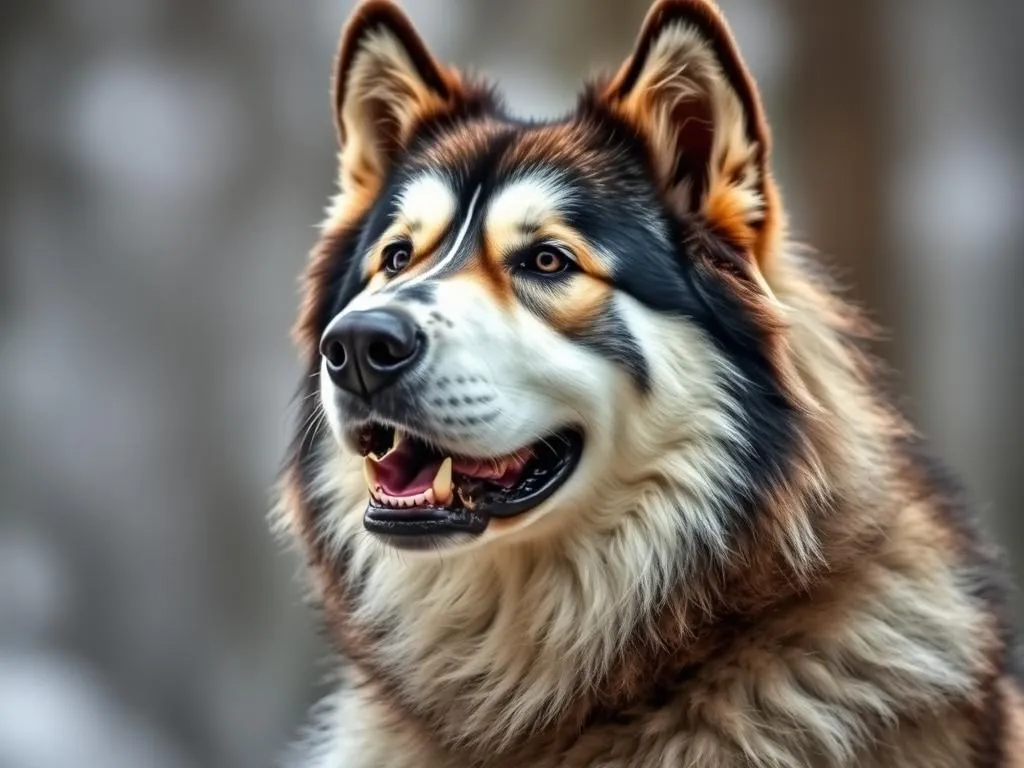
Introduction
Dog breeds play a crucial role in shaping our lives, acting as companions, workers, and even family members. Among the diverse array of breeds, the Alaskan Malamute stands out due to its impressive strength, striking appearance, and rich history. This breed has not only been a faithful companion to many but also a reliable worker in harsh environments. Understanding the characteristics of the Alaskan Malamute is essential for anyone considering bringing one into their home, ensuring a harmonious relationship between dog and owner.
Overview of Dog Breeds
Definition of Dog Breeds
A dog breed is a specific strain or variety of domestic dog, distinguished by particular traits such as size, coat type, and behavior. These characteristics are shaped by genetics and selective breeding practices, which have resulted in the myriad of breeds we see today. Each breed has unique attributes, making them suitable for particular roles in human society, whether as service animals, hunting partners, or loyal companions.
Purpose of Dog Breeds
Historically, different breeds have been developed to fulfill specific functions. Some breeds, like the Alaskan Malamute, were bred for strength and endurance, serving as sled dogs in harsh Arctic conditions. Others, such as herding breeds, were designed to help manage livestock. The adaptation of breeds to various environments and tasks showcases their significance in human culture and the bond formed between humans and dogs.
The Alaskan Malamute: A Breed Profile
History and Origin
The Alaskan Malamute is one of the oldest Arctic sled dog breeds, with origins tracing back thousands of years to the Mahlemut tribe of Alaska. This breed was developed for heavy hauling and companionship, showcasing their incredible strength and endurance. Traditionally, they were used in hunting and transportation, proving invaluable in the harsh Arctic landscapes.
The influence of indigenous peoples on the breed is profound, as they selectively bred the Alaskan Malamute for traits that would enable them to thrive in difficult conditions. This close connection with humans has shaped the breed’s temperament, making them loyal and affectionate companions.
Physical Characteristics
The Alaskan Malamute is a large and powerful dog, typically weighing between 75 to 100 pounds and standing at 23 to 25 inches tall at the shoulder. They possess a thick, double coat that provides insulation against cold weather, usually featuring shades of gray, black, sable, or red, with white markings on the face, chest, and legs.
Distinctive features include erect, triangular ears and a plume-like tail that curls over their back. Their eyes can be brown or blue, adding to their striking appearance. The combination of strength and beauty makes the Alaskan Malamute an impressive sight.
Temperament and Behavior
The Alaskan Malamute is known for its friendly and loyal demeanor. They are social animals that thrive on companionship, making them excellent family dogs. However, they also possess a strong independent streak, which can lead to challenges in training if not addressed appropriately.
Their behavior tends to be playful and affectionate, but early socialization is essential to ensure they develop into well-rounded adults. They typically get along well with children and other pets, although their strong prey drive may lead to chasing smaller animals. Understanding their temperament is vital for potential owners to foster a positive living environment.
Care and Maintenance
Diet and Nutrition
Feeding an Alaskan Malamute requires attention to their unique dietary needs. A high-quality, protein-rich diet helps maintain their muscle mass and energy levels. It’s important to choose dog food formulated for large breeds, as this ensures they receive the right balance of nutrients.
Common dietary needs include adequate levels of Omega-3 and Omega-6 fatty acids, which promote a healthy coat and skin. Owners should consult their veterinarian to design an appropriate feeding plan, considering factors like age, activity level, and health status.
Exercise Requirements
The Alaskan Malamute is a high-energy breed that requires regular exercise to stay healthy and happy. Engaging them in physical activities like hiking, running, or even sledding (their traditional role) is crucial. Ideally, they should receive at least 1-2 hours of vigorous exercise each day to prevent boredom and destructive behavior.
Being an athletic breed, they thrive in environments where they can explore and engage in activities that challenge their physical and mental capabilities.
Grooming Needs
Grooming an Alaskan Malamute involves regular brushing to manage their thick coat and minimize shedding. They have a seasonal shedding cycle, typically losing their undercoat in spring and fall, requiring more frequent grooming during these periods.
In addition to coat care, dental hygiene and ear cleaning are essential. Regular veterinary check-ups will help ensure overall health and address any grooming needs specific to the individual dog.
Health Considerations
Common Health Issues
While Alaskan Malamutes are generally healthy, they are predisposed to certain health issues. Common conditions include hip dysplasia, elbow dysplasia, and certain hereditary diseases like hypothyroidism and inherited cataracts. Responsible breeding practices can help mitigate these risks, so potential owners should seek reputable breeders who conduct health screenings.
Preventive Care
Regular veterinary check-ups are vital for maintaining the health of an Alaskan Malamute. Vaccinations and parasite control are critical components of preventive care. Keeping up with these measures can help prevent common illnesses and ensure a longer, healthier life for your dog.
Lifespan and Aging
The average lifespan of an Alaskan Malamute ranges from 10 to 14 years. As they age, their care requirements may shift. Senior dogs may need a diet adjusted for their metabolism and joint health, as well as modified exercise routines that accommodate their stamina.
Training and Socialization
Basic Training Techniques
Effective training for an Alaskan Malamute requires patience, consistency, and positive reinforcement. This breed is intelligent, but their independent nature can lead to stubbornness. Using treats and praise can motivate them and reinforce desired behaviors.
Starting training early is essential. Basic commands such as sit, stay, and come should be taught in a fun and engaging manner. Incorporating mental stimulation through puzzle toys can also enhance their training experience.
Socialization Strategies
Early socialization is crucial for an Alaskan Malamute. Exposing them to various environments, people, and other animals will help them develop confidence and reduce the likelihood of behavioral issues. Puppy classes and playdates are excellent ways to facilitate this process.
Regular outings to parks or community events allow them to interact with other dogs and people, promoting positive experiences that shape their social skills.
Behavioral Challenges
Some common behavioral challenges with Alaskan Malamutes include stubbornness and separation anxiety. Owners should be proactive in addressing these issues through training and socialization. Creating a structured routine can help alleviate anxiety, while consistent training can combat stubbornness.
Introducing crate training can provide a safe space for the dog and aid in reducing separation anxiety when the owner is not home.
Living with an Alaskan Malamute
Ideal Living Environment
Alaskan Malamutes thrive in environments where they have plenty of space to roam and play. While they can adapt to urban living, they do best in homes with a yard or access to open spaces. Their strong prey drive and need for exercise make rural living ideal, allowing them to explore and engage in physical activities.
Interaction with Family Members
Alaskan Malamutes are known for their affectionate nature, often forming strong bonds with their family members. They typically interact well with both adults and children, making them suitable family pets. However, supervision is essential when introducing them to younger children, as their size and energy can unintentionally lead to rough play.
Travel and Adventures
Traveling with an Alaskan Malamute can be a rewarding experience, provided some precautions are taken. Ensuring the dog is comfortable and well-hydrated during travel is crucial. When hiking or engaging in outdoor activities, keeping them leashed in unfamiliar areas is advisable to prevent them from chasing wildlife.
Preparation is key for adventures, including ensuring they have proper gear, such as a good-quality harness, and being aware of their limits regarding physical exertion in different climates.
Conclusion
The Alaskan Malamute is a magnificent breed known for its strength, loyalty, and affectionate nature. Understanding their unique needs and characteristics is essential for potential owners to ensure a fulfilling relationship with this remarkable breed. While the Alaskan Malamute can bring immense joy and companionship, they also require dedication, patience, and proper care to thrive.
Owning an Alaskan Malamute is a rewarding experience, filled with love and adventure. By being informed and prepared, potential owners can appreciate the joys and challenges that come with this extraordinary breed.
FAQs
What is the average cost of an Alaskan Malamute?
The cost of an Alaskan Malamute can vary widely, typically ranging from $1,000 to $2,500, depending on the breeder and location.
Are Alaskan Malamutes good with other pets?
Alaskan Malamutes can coexist with other pets, especially if properly socialized from a young age. However, their strong prey drive may lead to chasing smaller animals.
How do I choose a reputable breeder?
To choose a reputable breeder, look for those who prioritize health testing, provide a clean and healthy environment for their dogs, and are willing to answer questions about the breed’s characteristics and care needs.









